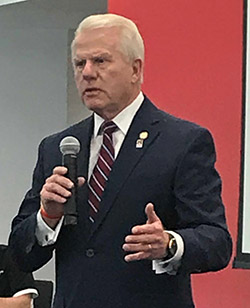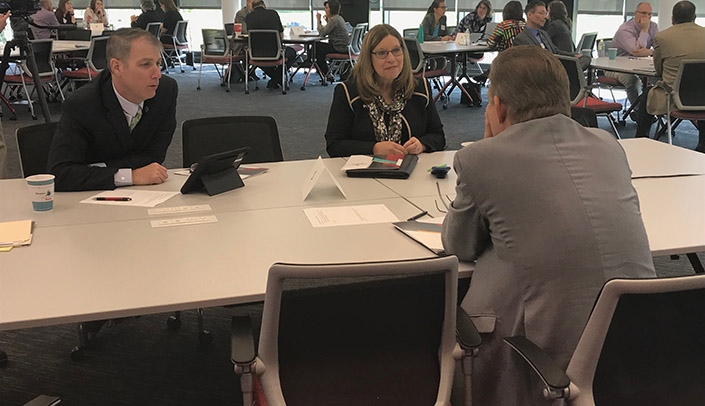Building on more than two decades of success, about 50 leaders from UNMC, Nebraska’s state colleges and the University of Nebraska at Kearney gathered in Lincoln on May 16 to strengthen “pathway programs” for students to enter the health professions, then return to rural areas to practice.
“The pathway programs have been successful in returning many students to rural areas to practice, but rural health workforce challenges continue, and our health care system is changing,” said Nikki Carritt, director of rural health initiatives at UNMC. “The summit provided us with an opportunity to provide feedback on where the pathway programs currently are, as well as discuss strategies we collectively could take to improve them.”
 |
Sen. Matt Williams of Gothenburg spoke at the summit, stressing the importance of growing the health care workforce for rural areas of the state. |
Nebraska’s rural pathway programs date back to the early 1990s. Early on, UNMC partnered with the state colleges to provide guaranteed admittance to programs, with expectations that students would spend significant time training in rural areas and then return there to practice. Today, nine professions at UNMC participate in the Rural Health Opportunities Program (RHOP) with state colleges and the Kearney Health Opportunities Program (KHOP) at UNK. Another program in public health, PHEAST, also attracts rural students. A fourth program, Urban Health Opportunities Program (UHOP), targets underserved urban areas.
Through 2017, more than 587 students had graduated from the programs targeting rural areas. Of those, 44 percent were still practicing in rural Nebraska, and another 18 percent practiced in urban Nebraska.
“There’s no question these pathway programs have had success in placing providers in rural Nebraska,” Bartee said. “With changes to the rural health landscape over the past 25 years, now is the time to infuse new creativity and energy to meet these changing needs. The summit really crystalized some innovative ideas to move forward.”
Carritt said that a report from the summit will highlight those ideas, as well as action steps for moving forward.
“Bringing together stakeholders to brainstorm on these programs was invaluable,” Carritt said. “I’m excited to see how we can even better serve rural Nebraska over the next 25 years.”
